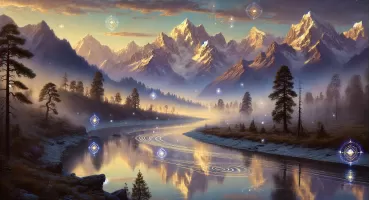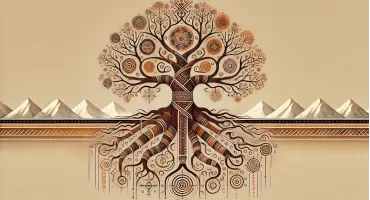In my work with Kirati Khambu Rai cultural organizations and through engaging with other groups such as the Tamangs, Magars, and Gurungs, I’ve frequently encountered a telling phrase in Nepali that culture enthusiasts often repeat: “Bhai, khas ma chai hamro parampara/ritithiti/bhesbhusa yesto rahecha ni,” which translates to, “Brother, originally our customs/rituals/traditional attire were like this.”
A friend of mine, Ashish, who advocates for embracing modern cultural movements, once remarked with a touch of scepticism, “If we’re talking about the original traditional attire of every culture, it would be leaves and animal skins.” Though his comment was made with a playful intent to provoke someone like me, it holds an undeniable element of truth.
Today, when indigenous Himalayan communities gather to celebrate their festivals in open fields, they assert their identity through distinct ethnic symbols. These include traditional attire, often woven in fabrics whose style, colour, and patterns signify their ‘clan’ or identity. Interestingly, while these elements are ascribed great antiquity, there is little evidence to support their age-old origins. In fact, much of this “traditional” apparatus is either modern or influenced by later cultural developments. For instance, most Himalayan tribes have upper garments for men, yet their lower attire is often the Daura Suruwal—an outfit widely acknowledged as non-indigenous to the tribes of the Himalayas. Adding to this, many men wearing traditional upper garments opt to pair them with jeans. Attires change, and so does culture, reflecting the uncertainty of both tradition and identity.

Thus, it can be said that culture is not a static construct but a dynamic, ever-evolving force influenced by history, environment, and human interaction. This fluidity is particularly evident in Himalayan societies, where traditions have been shaped by the flow of time, external influences, organized religions, and the shifting needs of communities. From a sociological perspective, it becomes clear that while some traditions fade with time, others adapt, endure, and evolve reflecting the resilience and creativity of human societies. Yet, one might contend that even as culture evolves, it must be preserved to uphold a robust cultural identity. Without this, what remains of its essence?
Here, it is crucial to recognize the distinction between preserving culture and clinging uncritically to archaic traditions. The former fosters a unique identity, nurturing kinship and belonging, while the latter risks suffocating a community’s natural growth. Just as ecosystems flourish through adaptation and change, so too must cultures transform to stay vibrant. For communities like the Kirati Khambu Rai, who have long drawn inspiration from nature, resisting cultural change and embracing rigidity would be a profound irony.
What truly deserves preservation is not the entirety of culture in its static form but those traditions that enrich a community’s sense of identity. Accepting the fluidity of culture is essential—allowing it to shift and adapt organically ensuring its relevance in changing times. By embracing this natural flow, communities can honour their heritage while making space for innovation and new expressions, so that their traditions remain vibrant and meaningful for generations to come.
Thomas Sowell, a distinguished economist and social theorist, has delved deeply into the evolution of cultures and traditions, particularly in the context of conquests and cultural exchanges. In his book Conquests and Cultures: An International History, Sowell examines how cultural differences, both within and between nations, have shaped the economic and social trajectories of peoples and civilizations across centuries. This observation resonates in the context of the Himalayas, where communities have continually reshaped their traditions to adapt and survive amidst the challenges of the modern world.
Sowell argues that cultural evolution is significantly influenced by historical events such as conquests, migrations, and the dissemination of human capital. He suggests that while some cultural elements are lost or transformed through these processes, others adapt and endure, contributing to the dynamic nature of cultural identity. This perspective aligns with the observation that traditions, including those in the Himalayan region, are subject to change and amalgamation over time.

The Himalayan region, known for its rich diversity, offers a microcosm of how cultures interact and evolve. Communities like the Kiratis, Tamangs, Gurungs, and Magars have developed unique traditions over centuries, but these traditions have not remained isolated. Trade, migration, and religious influences have facilitated a continuous exchange of ideas, rituals, and philosophies.
Take, for instance, the Kiratis of the ancient Kathmandu Valley. Their traditions, as described in ancient Lichhavi inscriptions, differ vastly from those practiced by Kiratis today. These inscriptions mention the veneration of Matindevkul, a female deity revered by the ancient Kirats. However, its connection to the modern reverence for Sumnima by the Kirat Rais or Yuma by the Limbus remains uncertain. Similarly, indigenous groups also honour feminine powers in various forms—be it Ajima of the Newars, Machakomma of the Chamlings, Mangchemma of the Bantawas, or Honku Mang, the divine female river spirit, alongside the more universal “Boju Devi.”
What is unclear, however, is whether the ancient Matindevkul has evolved into these household female spirits, now worshipped distinctly by each community, or whether her significance has been quietly diminished over time. This ambiguity underscores the dynamic nature of cultural transformation, where fluidity shapes new practices while leaving parts of the past in shadows.
In The Invention of Tradition, Eric Hobsbawm and Terence Ranger write, “We should expect it (invention of tradition) to occur more frequently when a rapid transformation of society weakens or destroys the social patterns for which ‘old’ traditions had been designed, producing new ones to which they were not applicable, or when such old traditions and their institutional carriers and promulgators no longer prove sufficiently adaptable and flexible, or are otherwise eliminated.”
This statement highlights how traditions adapt in response to societal changes. As communities encounter rapid transformations—whether from external influences, shifting needs, or modern pressures—their old traditions may no longer be effective. In such situations, new traditions are often created or adjusted to help communities preserve their identity while navigating the changing landscape.
Historical shifts, including the rise of Hinduism and Buddhism, have introduced new elements while marginalizing some older practices. Yet, amidst these changes, certain traditions persist because they hold deep significance, acting as cultural anchors. This phenomenon illustrates a critical point: cultural elements that endure are often those revered or deemed essential by their communities. At the same time, the loss of certain practices is inevitable, reflecting changing priorities, environments, and values.

Shamanism, a cornerstone of many Himalayan cultures, exemplifies the fluid nature of traditions. Historically rooted in animism and the deep connection between humans and nature, shamanism has undergone various changes over time. External religious influences, such as Hindu and Buddhist philosophies, have introduced syncretic practices. Tamang shamans (Bompos) may integrate Buddhist mantras into their rituals while preserving core elements like the Lha (soul) and the shamanic journey.
One key insight is that traditions do not survive solely because of historical continuity. They endure because they are revered—imbued with meaning and value by the community. Rituals, songs, and festivals tied to shamanic practices or nature worship continue in part because they resonate deeply with cultural identity and collective memory.
However, the reverence for certain practices also raises questions about what is lost. When oral traditions fade, or languages erode, the intricate details of rituals and cosmologies risk being forgotten. This loss does not diminish the adaptability of culture but highlights the importance of documentation and preservation efforts. Ethnographic studies, storytelling, and education are crucial in ensuring that even fading traditions find a place in the broader narrative of human history.
The fluid nature of culture is both its strength and its vulnerability. As traditions adapt to new circumstances, they demonstrate resilience, but this process also entails the loss of practices that no longer seem relevant. Environmental changes, shifting societal needs, and external pressures all contribute to this duality.
The story of Himalayan civilizations illustrates that culture is not a monolith but a living, breathing phenomenon. While acknowledging the inevitability of change, it is essential to preserve and document traditions that form the foundation of a community’s identity. Efforts to safeguard languages, rituals, and oral histories are not about resisting change but about ensuring that the essence of a culture endures through its evolution.
Only if we ponder upon the transformative nature of traditions, and accept it, can we truly achieve a balance—celebrating the dynamism of culture while honouring the legacy of the past. In doing so, we recognize that even as traditions change, they endure as crucial components in the continuous evolution of human civilization.





Leave a Reply